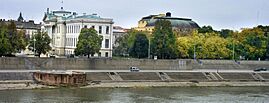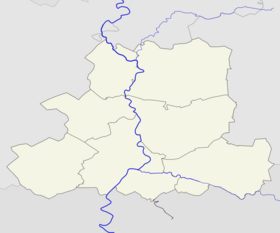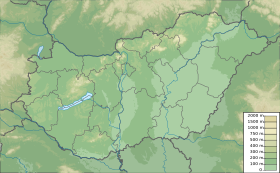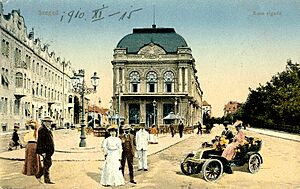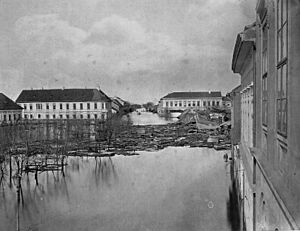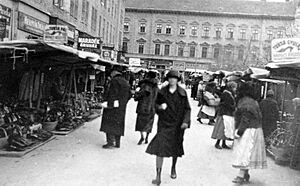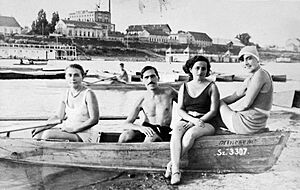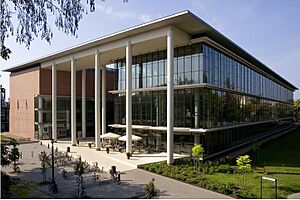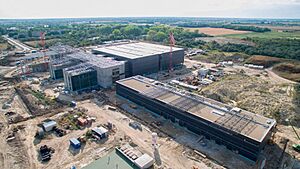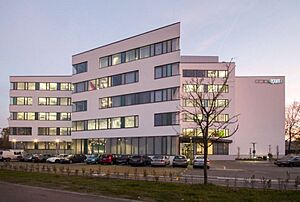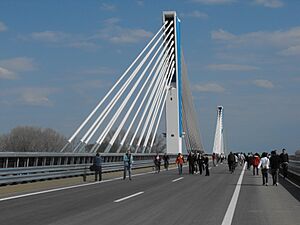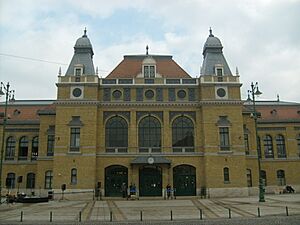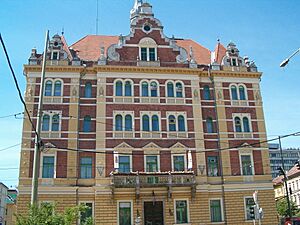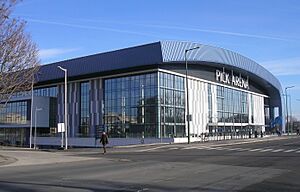Szeged facts for kids
Quick facts for kids
Szeged
|
|||
|---|---|---|---|
|
City with county rights
|
|||
| Szeged Megyei Jogú Város | |||
|
|||
|
|||
| Nickname(s):
City of Sunshine (Napfény városa)
|
|||
| Country | |||
| Region | Southern Great Plain | ||
| County | Csongrád-Csanád | ||
| District | Szeged | ||
| City status | 1498 | ||
| Area | |||
| • City with county rights | 280.84 km2 (108.43 sq mi) | ||
| Area rank | 11th in Hungary | ||
| Elevation | 76 m (249.34 ft) | ||
| Highest elevation | 76.7 m (251.6 ft) | ||
| Lowest elevation | 75.8 m (248.7 ft) | ||
| Population
(2019)
|
|||
| • City with county rights | 160,766 | ||
| • Rank | 3rd in Hungary | ||
| • Density | 612.28/km2 (1,585.8/sq mi) | ||
| • Urban | 239,025 (7th) | ||
| Demonym(s) | szegedi | ||
| Population by ethnicity | |||
| • Hungarians | 83.9% | ||
| • Romani | 0.9% | ||
| • Germans | 0.9% | ||
| • Serbs | 0.8% | ||
| • Romanians | 0.3% | ||
| • Slovaks | 0.2% | ||
| • Other | 2.1% | ||
| Population by religion | |||
| • Roman Catholic | 36.4% | ||
| • Greek Catholic | 0.4% | ||
| • Calvinists | 4.8% | ||
| • Lutherans | 1.2% | ||
| • Jews | 0.1% | ||
| • Other | 2.4% | ||
| • Non-religious | 23.4% | ||
| • Unknown | 31.4% | ||
| Time zone | UTC+01:00 (CET) | ||
| • Summer (DST) | UTC+02:00 (CEST) | ||
| Postal code |
6700 to 6729, 6753, 6757, 6771, 6791
|
||
| Area code | (+36) 62 | ||
| Motorways | M5 Motorway M43 Motorway |
||
| NUTS 3 code | HU333 | ||
| Distance from Budapest | 162.8 km (101.2 mi) Northwest | ||
| Airport | Szeged (LHUD) | ||
| MPs |
List
Sándor Szabó (Hungarian Socialist Party) Csongrád-Csanád County 1st constituency
Béla Mihálffy (Fidesz–KDNP) Csongrád-Csanád County 2nd constituency |
||
Szeged is the third largest city in Hungary. It is the biggest city and main center of the Southern Great Plain region. Szeged is also the capital of Csongrád-Csanád county. The University of Szeged is one of the best universities in Hungary.
Every summer, the Szeged Open Air Festival takes place. It started in 1931. May 21st is celebrated as the Day of the City.
Contents
- What's in a Name? The Meaning of Szeged
- A Look Back: The History of Szeged
- Where is Szeged? The City's Geography
- Learning in Szeged: Education and Research
- Szeged's Economy: Food and More
- Getting Around: Transport in Szeged
- Sports in Szeged
- Must-See Places: Main Sights of Szeged
- News and Entertainment: Media in Szeged
- Famous Faces: Notable People from Szeged
- Connecting Globally: Twin Towns and Sister Cities
- Images for kids
- See also
What's in a Name? The Meaning of Szeged
The name Szeged might come from an old Hungarian word, szeg. This word means "corner," possibly because of the way the Tisza river bends as it flows through the city.
Some people think the name comes from sziget, which means "island." Others believe szeg means "dark blond," referring to the color of the water where the Tisza and Maros rivers meet.
Long ago, the Romans had a town called Partiscum near Szeged. Some think Szeged might be a changed version of this old Roman name.
Szeged has different names in other languages. For example, in German it's Szegedin, and in Serbo-Croatian it's Segedin.
A Look Back: The History of Szeged
People have lived in the Szeged area for a very long time. An ancient Roman trading post was built on an island in the Tisza River. The city's name, Szeged, was first written down in 1183.
From Destruction to Rebuilding
The town was destroyed during the Mongol invasion. But people soon returned and rebuilt it. In the 14th century, Szeged became a very important town in Southern Hungary. As armies from the Ottoman Empire got closer, Szeged became even more important for defense. A wall was built around the town. In 1498, Szeged became a "free royal town," which meant it had special rights.
The Ottomans took control of Szeged in 1543. They ruled it for many years. Szeged was freed from Ottoman rule in 1686. In 1715, it got its special "free royal town" status back. The city's coat of arms, which is still used today, was given to Szeged in 1719.
Growth and Challenges
Szeged grew and became successful in the 1700s. The first printing press opened in 1801. The city also built a new town hall and a hospital.
Szeged is famous for paprika, a spice made from dried peppers. Paprika came to Hungary in the 1500s as a decorative plant. About 100 years later, people started growing it for food. Szeged is also known for its delicious goulash and fish soup called halászlé.
The people of Szeged played a big part in the Hungarian Revolution of 1848. The city was the last place where the revolutionary government met in 1849. After the revolution, Szeged started to grow again. A railway line reached the city in 1854.
In 1879, a huge flood wiped out almost the entire city. Only a few houses were left. Emperor Franz Joseph promised that Szeged would be rebuilt even more beautifully. He kept his word. A new, modern city with wide streets and grand buildings rose from the ruins.
Szeged in the 20th Century
After World War I, Hungary lost some southern lands. Szeged became a border city, which changed its importance. However, it slowly recovered by taking on new roles. In 1921, the University of Kolozsvár moved to Szeged, becoming the University of Szeged.
Szeged faced difficulties during World War II. Many people were killed. After the war, during the communist era, Szeged became a center for light industry and food production. Oil was discovered near the city in 1965.
In 1962, Szeged became the county seat of Csongrád. New parts of the city were built. Several nearby villages became part of Szeged in 1973. Today, Szeged is an important university city and a popular place for tourists. The Szeged Symphony Orchestra often performs at the Szegedi Nemzeti Színház.
Where is Szeged? The City's Geography
Szeged is located in southern Hungary. It sits on both sides of the Tisza River, just south of where the Maros River flows into it. The city is almost in the middle of the Carpathian Basin. The border between Hungary and Serbia is very close to Szeged.
Szeged's Climate: The City of Sunshine
Szeged has warm summers and cold winters. It doesn't get a lot of rain. Because it has many sunny days each year, Szeged is often called the City of Sunshine (Napfény városa).
| Climate data for Szeged, 1991–2020 | |||||||||||||
|---|---|---|---|---|---|---|---|---|---|---|---|---|---|
| Month | Jan | Feb | Mar | Apr | May | Jun | Jul | Aug | Sep | Oct | Nov | Dec | Year |
| Record high °C (°F) | 17.5 (63.5) |
20.5 (68.9) |
24.9 (76.8) |
31.6 (88.9) |
34.0 (93.2) |
38.0 (100.4) |
39.6 (103.3) |
39.4 (102.9) |
37.6 (99.7) |
29.1 (84.4) |
23.5 (74.3) |
16.5 (61.7) |
39.6 (103.3) |
| Mean daily maximum °C (°F) | 3.4 (38.1) |
6.3 (43.3) |
12.1 (53.8) |
18.5 (65.3) |
23.2 (73.8) |
26.9 (80.4) |
28.9 (84.0) |
29.4 (84.9) |
23.8 (74.8) |
17.7 (63.9) |
10.6 (51.1) |
4.1 (39.4) |
17.1 (62.8) |
| Daily mean °C (°F) | −0.1 (31.8) |
1.6 (34.9) |
6.4 (43.5) |
12.0 (53.6) |
16.9 (62.4) |
20.6 (69.1) |
22.3 (72.1) |
22.4 (72.3) |
17.2 (63.0) |
11.7 (53.1) |
6.1 (43.0) |
1.0 (33.8) |
11.5 (52.7) |
| Mean daily minimum °C (°F) | −3.0 (26.6) |
−2.3 (27.9) |
1.3 (34.3) |
6.1 (43.0) |
10.9 (51.6) |
14.3 (57.7) |
15.7 (60.3) |
15.8 (60.4) |
11.4 (52.5) |
6.7 (44.1) |
2.5 (36.5) |
−1.7 (28.9) |
6.5 (43.7) |
| Record low °C (°F) | −25.1 (−13.2) |
−23.1 (−9.6) |
−19.6 (−3.3) |
−6.8 (19.8) |
0.9 (33.6) |
3.9 (39.0) |
6.2 (43.2) |
7.5 (45.5) |
1.0 (33.8) |
−7.9 (17.8) |
−11.9 (10.6) |
−25.0 (−13.0) |
−25.1 (−13.2) |
| Average precipitation mm (inches) | 27.3 (1.07) |
30.1 (1.19) |
29.7 (1.17) |
36.6 (1.44) |
60.8 (2.39) |
75.3 (2.96) |
61.6 (2.43) |
43.5 (1.71) |
49.1 (1.93) |
44.6 (1.76) |
37.0 (1.46) |
39.3 (1.55) |
534.9 (21.06) |
| Average precipitation days (≥ 1.0 mm) | 6.0 | 5.8 | 5.7 | 5.8 | 7.8 | 8.1 | 6.6 | 5.5 | 6.8 | 6.1 | 6.3 | 7.0 | 77.5 |
| Average relative humidity (%) | 86.9 | 80.2 | 69.9 | 64.9 | 67.0 | 68.4 | 65.9 | 64.6 | 70.0 | 76.5 | 83.3 | 87.9 | 73.8 |
| Mean monthly sunshine hours | 59 | 94 | 143 | 173 | 234 | 252 | 278 | 263 | 199 | 153 | 77 | 53 | 1,978 |
| Source 1: NOAA | |||||||||||||
| Source 2: WMO (sunshine 1981–2010) | |||||||||||||
Learning in Szeged: Education and Research
Szeged has many schools, including 62 kindergartens, 32 elementary schools, and 18 high schools. Some of its high schools are among the best in Hungary.
Szeged is a major center for higher education in Southern Hungary. Thousands of students, including many from other countries, study here. The University of Szeged is the second largest and fourth oldest university in Hungary, founded in 1581. It is known as one of the top universities in the country and Europe.
The Biological Research Centre is another important place for science in Szeged. Scientists there made "artificial heredity material" in 2000, which was a world first. The Szent-Györgyi Albert Agóra is a cultural and science center. It has labs from the Biological Research Centre and exhibits about computer history.
In 2018, a new science center called the ELI Attosecond Light Pulse Source (ELI-ALPS) opened in Szeged. This special facility creates very fast light pulses for physics experiments. Szeged is also a popular place for medical students from all over Europe.
Szeged's Economy: Food and More
Szeged is a key center for the food industry in Hungary. It is especially known for its paprika. Big food companies like Pick Szeged and Sole-Mizo are based here. Other important companies in Szeged include AMSY International and Generál Printing House.
Some large companies like ContiTech and Duna-Dráva Cement have factories in Szeged. The Hangár Expo and Conference Centre hosts international events.
Top Employers in Szeged
| # | Employer | # of Employees |
|---|---|---|
| 1 | University of Szeged | 5,000 < |
| 2 | Pick Szeged | 2,000–4,999 |
| 3 | Sole-Mizo | 1,000–1,999 |
| 4 | Tisza-Volán | 1,000–1,999 |
| 5 | EDF-Démász | 500–999 |
| 6 | Suli-Host | 500–999 |
| 7 | Szegedi Közlekedési Társaság | 500–999 |
| 8 | Szegedi Szefo | 500–999 |
| 9 | Coop | 300–499 |
| 10 | Engie | 300–499 |
Getting Around: Transport in Szeged
Szeged is a major transport hub in Southern Hungary. Two important motorways, M5 and M43, pass by the city. The M5 connects Szeged to Budapest in the north and to cities in Serbia like Subotica in the south. The M43 connects Szeged to Arad and Timișoara in Romania.
Szeged also has important railway lines. The Budapest-Szeged line is a key connection. Other lines go to places like Makó and Hódmezővásárhely.
A new tram-train system opened in 2021. It connects Szeged with the nearby city of Hódmezővásárhely. This creates a larger urban area. There are also many long-distance buses that stop in Szeged.
Main Roads and Railways
- Motorways: M5, M43
- Railways: Lines 121 (to Makó), 135 (to Hódmezővásárhely), 136 (to Röszke), 140 (to Kiskunfélegyháza)
Air Travel
Szeged Airport is the city's international airport.
Public Transport in the City
Public transport in Szeged is managed by Szeged Transport Ltd. (SZKT) and Volánbusz. The main public transport options are 5 tram lines and 6 trolleybus lines. These are supported by 38 bus lines. Hungarian State Railways runs regional, intercity, and international trains.
Sports in Szeged
Handball
Handball is the most popular sport in Szeged. The city's famous club, SC Pick Szeged, plays in Hungary's top league. They won the 2013–14 EHF Cup. Their home games are played at the Pick Aréna, which opened in 2021.
Football
Football is also very popular. Szeged has had several clubs play in Hungary's top football league. The club Szeged 2011 currently plays in the second league.
- Szeged 2011
- Szegedi Egységes Oktatási Labdarúgó SC
- Szegedi VSE
Speedway
Motorcycle speedway has a long history in Szeged. There used to be a speedway track where the Pick Aréna is now. Later, a new track was built. This track hosted important international races. The speedway track eventually moved outside the city.
Must-See Places: Main Sights of Szeged
| Votive Church (1930) | 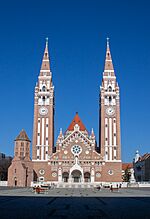 |
Dömötör Tower (11th century) | 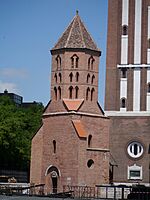 |
The Water Tower of Szent István Square (1904) | 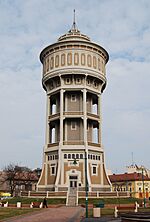 |
| Church of Grey Friars (Gothic, 15th century) | 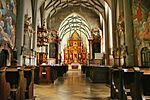 |
Ferenc Móra Museum (1896) | 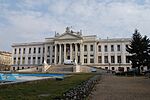 |
Reök palace (1907) | 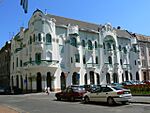 |
| City Hall (1728, 1804, 1883) | 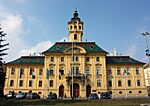 |
Szeged Synagogue | 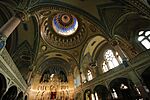 |
National Theatre of Szeged | 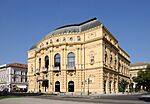 |
| Gróf-palace (1913) | 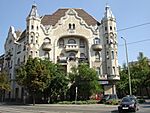 |
The Main Building of the University | 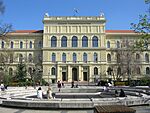 |
Saint Nicholas Serbian Orthodox Church (1781) | 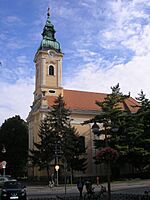 |
News and Entertainment: Media in Szeged
Szeged has many different types of media. These include TV and radio stations, as well as newspapers and online news sites.
TV Stations
- Szeged TV
- Tarjáni Kábeltévé Stúdió
- TiszapART TV
- Telin Televízió
Radio Stations
- "Rádió 88" FM 95,4 MHz
- All in Party Radio
- Rádió Mi, 89,9 MHz
- Lánchíd Rádió, FM 100,2 MHz
- MR1 Kossuth Rádió, FM 90,3 MHz
- MR2 Petőfi Rádió, 104,6 MHz
- MR3 Bartók Rádió, 105,7 MHz
- Dankó Rádió, 93,1 MHz
- Rádió1, 87,9 MHz
Daily Newspapers and News Websites
- Délmagyarország ()
Famous Faces: Notable People from Szeged
- Gábor Agárdy (1922–2006), actor
- Béla Balázs (1884–1949), writer and film critic
- János Csonka (1852–1939), engineer, helped invent the carburetor
- Attila Czene (1974), Olympic champion swimmer
- Rajmund Fodor (1976), Olympic champion water polo player
- Jenő Huszka (1875–1960), composer
- Éva Janikovszky (1926–2003), writer
- Gyula Juhász (1883–1937), poet
- Géza Maróczy (1870–1951), chess grandmaster
- Anita Márton (1989), shot putter
- Tamás Molnár (1975), Olympic champion water polo player
- Nickolas Muray (1892–1965), famous photographer
- György Sebők (1922–1999), pianist
- Attila Vajda (1983), Olympic champion canoer
- Vilmos Zsigmond (1930), cinematographer
People Who Lived in Szeged
- Mihály Babits, poet and writer
- Ferenc Fricsay, conductor
- Attila József, poet
- Katalin Karikó, Nobel Prize winner biochemist
- Dezső Kosztolányi, poet and novelist
- Peter Leko, chess grandmaster
- Ferenc Móra, writer and archaeologist
- Miklós Radnóti, poet
- Albert Szent-Györgyi, Nobel Prize winner chemist and biologist
Connecting Globally: Twin Towns and Sister Cities
Szeged has special partnerships with many cities around the world. These are called twin towns or sister cities.
 Cambridge, United Kingdom (1987)
Cambridge, United Kingdom (1987) Darmstadt, Germany (1990)
Darmstadt, Germany (1990) Larnaca, Cyprus (1994)
Larnaca, Cyprus (1994) Liège, Belgium (2001)
Liège, Belgium (2001) Łódź, Poland (2004)
Łódź, Poland (2004) Nice, France (1969)
Nice, France (1969) Odesa, Ukraine (1957)
Odesa, Ukraine (1957) Parma, Italy (1988)
Parma, Italy (1988) Pula, Croatia (2003)
Pula, Croatia (2003) Subotica, Serbia (1966, renewed 2004)
Subotica, Serbia (1966, renewed 2004) Târgu Mureș, Romania (1997)
Târgu Mureș, Romania (1997) Timișoara, Romania (1998)
Timișoara, Romania (1998) Toledo, United States (1990)
Toledo, United States (1990) Turku, Finland (1971)
Turku, Finland (1971) Weinan, China (1999)
Weinan, China (1999)
Partner Cities
 Novi Sad, Serbia (2001)
Novi Sad, Serbia (2001)
Images for kids
-
Relief of King Matthias Corvinus of Hungary
-
Statue of King Béla IV of Hungary
-
Art Nouveau architecture
-
Szeged bridge on Tisza
See also
 In Spanish: Szeged para niños
In Spanish: Szeged para niños






